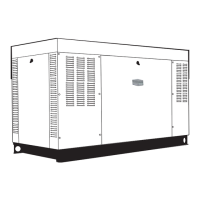
Do you have a question about the Generac Power Systems 005210-0 and is the answer not in the manual?
| Model Number | 005210-0 |
|---|---|
| Category | Inverter |
| Rated AC Power | 1600W |
| Maximum AC Power | 2000W |
| Power Output | 1600W |
| Peak Power Output | 2000W |
| Rated Voltage | 120V |
| Voltage | 120V |
| Rated Frequency | 60Hz |
| Frequency | 60Hz |
| Engine Displacement | 79 cc |
| Fuel Type | Gasoline |
| Fuel Tank Capacity | 1.06 gallons |
| Starting Method | Recoil |
| Weight | 46.3 lbs |
| Engine Type | OHV 4-Stroke |
| Dimensions | 19.7 x 11.4 x 17.9 inches |
| Noise Level | 60 dBA |
Manufacturer recommends installation, service, and repair by authorized personnel. Adhere to codes and regulations.
Generators produce dangerous voltages and can cause fatal electrical shock. Avoid contact with bare wires and ensure covers are in place.
Keep a fire extinguisher nearby. Do not use carbon tetrachloride type. Ensure proper ventilation.
Ensure proper ventilation to prevent explosive gas buildup. Do not smoke near the generator. Keep the area clean.
Understand all instructions before operating. Contact dealer if any part is not understood.
Operator is responsible for safety checks and prompt maintenance. Proper maintenance ensures fewer problems.
Contact an Authorized Service Dealer for servicing or repairs. Supply model and serial numbers.
Contains important information like serial number, voltage, amps, wattage, phase, frequency, RPM, and power factor.
Key to engineering and manufacturing details. Always supply when requesting service or parts.
Use high-quality detergent oil classified "For Service CC, SD, SE, SF." Use recommended SAE viscosity based on ambient temperature.
Use a mixture of half low silicate ethylene glycol base anti-freeze and deionized water. Add rust inhibitor if desired.
Shuts down the engine if coolant temperature exceeds 140°C (284°F).
Shuts down the engine if coolant level drops below a critical point to prevent overheating.
Shuts down the engine if oil pressure drops below 8 psi.
Stops cranking if the engine fails to start after a preset duration.
Shuts down the engine if it exceeds a safe, preset speed value.
Shuts down the engine if the speed signal to the control panel is lost.
Protects the control panel wiring and components from overload. Located inside the control panel.
Generator may be equipped with Natural Gas, Propane Vapor (PV), or LP Fuel System. Check Btu content and required fuel pressure.
Natural gas is supplied in vapor state. Requires proper pressure regulation and piping.
Utilizes vapors above liquid fuel in the supply tank. Best suited for smaller engines. Ambient temperatures affect efficiency.
LP is supplied as liquid and must be converted to gaseous state. Vaporizers are often used.
Details on type, rotor/stator insulation, harmonic distortion, TIF, output leads, bearings, coupling, load capacity, and excitation system.
Specifications for make, model, cylinders, displacement, bore, stroke, compression ratio, air intake, valve seats, and lifter type.
Details on oil pump type, oil filter, and crankcase oil capacity.
Specifications for water pump, fan speed, fan diameter, air flow, coolant capacity, heat rejection, and maximum operating temperatures.
Details on fuel type, carburetor, secondary fuel regulator, fuel shut-off solenoid, and operating fuel pressure.
Specifications for battery charge alternator, static battery charger, recommended battery, and system voltage.
Information on temperature and altitude deration adjustments.
Optional kit for cold climates, including battery warmer, junction box, and oil.
Steps to reconfigure the fuel system from Natural Gas to LP vapor.
Explains how AC connections are made based on voltage codes and stator assembly. Refers to wiring diagrams.
Describes generators designed for 240V, 1-phase, 60 Hz loads, with factory connections.
Explains generator power winding connections, including 3-phase alternators and their voltage ratings.
Details the design for 3-phase loads, winding connections, and rated voltages.
Instructions assume proper installation by a qualified contractor. Read safety rules.
NEC requires a transfer switch to prevent backfeed between electrical systems. Proper location and mounting are critical.
Ensure fuel supply delivers correct fuel at correct pressure, is purged, and leak tested. No fuel leakage permitted.
Check engine crankcase oil level before operating. Engine shipped with "break-in" oil. Check gearbox oil if equipped.
Generator must be properly prepared. Using incorrect fluids may result in engine failure.
Ensure cooling system is properly filled with recommended coolant mixture. Check for leaks.
Check engine fan belt tension and condition. Proper tension deflects belt about 3/8 to 5/8 inch.
Ensure generator is properly connected to earth ground. Ensure battery is charged and properly installed. Check electrical connections.
Check for freight damage, manuals, fluid levels, fuel piping, muffler installation, airflow, clearances, wiring, grounding, battery charger, control panel connections, and unit security.
Open battery charger breaker, remove control panel fuse, connect battery cables, close battery charger breaker, measure battery voltage.
Details a standard form completion and distribution for start-up inspections by authorized dealers.
Refer to the appropriate control panel operator's manual for unit control details.
Procedure for manual transfer switches that do not provide automatic start-up.
Steps for starting the engine and transferring load using a manual transfer switch. Includes safety warnings.
Steps to transfer load back to utility power and shut down the generator.
Details operation with automatic transfer switches like RTS, HTS, or GTS-type. Engine starts/stops automatically or manually.
Safety precautions before performing maintenance, including disconnecting power and removing fuses.
Check battery condition, test fuel system, check transfer switch, inspect exhaust, check ignition, and check fan belts.
Test engine safety devices like low oil pressure, low coolant level, and high coolant temperature.
Test engine governor, clean and inspect generator, and flush cooling system.
Change engine "break-in" oil and filter.
Change engine oil and filter, retorque cylinder head, and retorque intake/exhaust manifold.
Service air cleaner, check starter, and check engine DC alternator.
Retorque cylinder head, retorque intake/exhaust manifold, check engine compression, and check valve clearance.
Ensure air intake and outlet openings are unobstructed for proper operation. Overheating occurs without sufficient cooling air.
Engine controller is protected by a 15 amp fuse. Overcurrent protection devices will open if overloaded.
Check engine crankcase oil level, battery fluid level, and engine coolant level.
Start the generator engine once every seven days and run for at least 20 minutes.
Inspect hoses for damage, deterioration, leaks, and check hose clamps for tightness.
Visually inspect the entire engine-generator monthly for damage, loose fasteners, or leaks.
Inspect exhaust system pipes, mufflers, clamps for condition, tightness, and leaks.
Inspect fan belts every three months. Replace damaged or worn belts. Check belt tension.
Visually inspect the electronic governor. Do not attempt to adjust the governor.
Procedure for draining oil and replacing the oil filter. Ensure proper oil level and check for leaks.
Procedure for replacing the engine air cleaner filter.
Procedure for checking and adjusting spark plug gap or replacing spark plugs.
Annually have the cooling system drained, flushed, and refilled by an authorized service facility.
General maintenance tasks including cleaning the generator and inspecting insulation resistance.
Keep generator clean and dry. Periodically clean exterior surfaces and internal windings.
Precautions for handling batteries, including not using jumper cables and dangers of hydrogen gas.
Inspect battery posts, cables, and fluid levels. Check state of charge and condition.
Guidelines for replacing batteries, specifying the BCI Group No. and CCA rating.
Monthly inspection to ensure readiness and identify problem areas. Requires safety steps before maintenance.
One-time inspection after three months or 30 hours. Requires special tools and knowledge.
Semi-annual inspection for readiness and problem identification. Requires special tools and knowledge.
Annual inspection for readiness and problem identification. Requires special tools and knowledge.
Lists common causes for an engine not cranking, such as blown fuses, battery issues, or defective starter components.
Identifies causes like out of fuel, defective solenoid, open wires, or bad spark plugs for an engine that cranks but won't start.
Potential issues include plugged air cleaner, fuel line, defective spark plugs, or incorrect fuel pressure.
Common causes include low oil level, overheating, defective low oil pressure or coolant switches, or control module failure.
Troubleshooting for the AUTO/OFF/MANUAL switch and associated wiring or control module issues.
Checks for main breaker, circuit breaker/fuses, transfer switch position, generator failure, or thermal breaker.
Details the limited warranty for Generac standby/light commercial products, covering parts and labor for defects.
Outlines warranty coverage for components, parts, and labor for the first two years. Requires start-up and registration.
Lists exclusions from warranty coverage, such as normal maintenance, misuse, environmental damage, and unauthorized modifications.
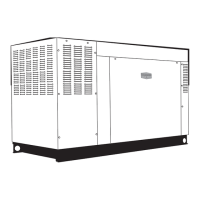
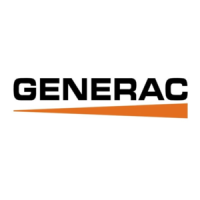
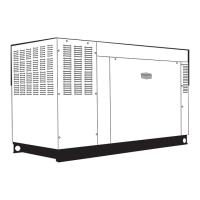



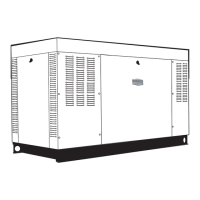

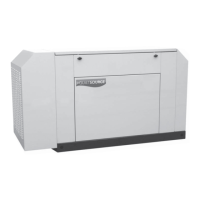


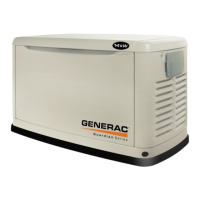
